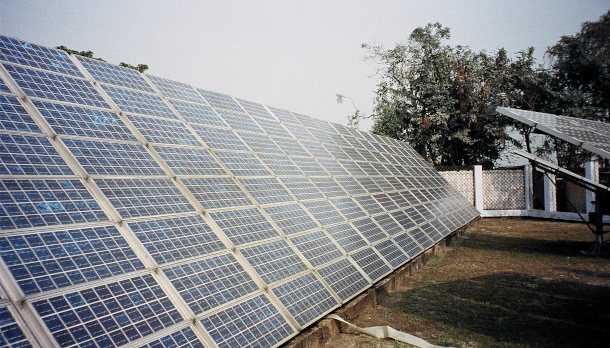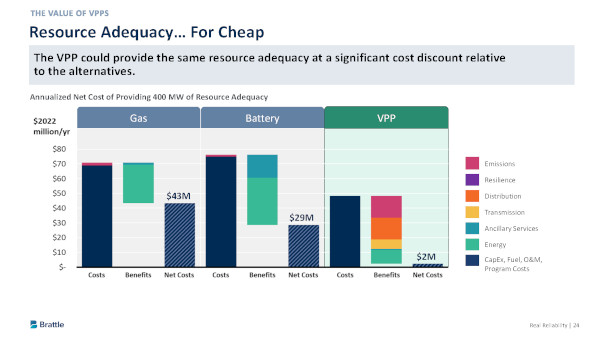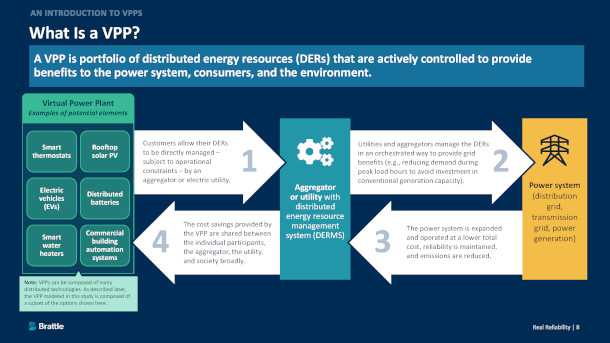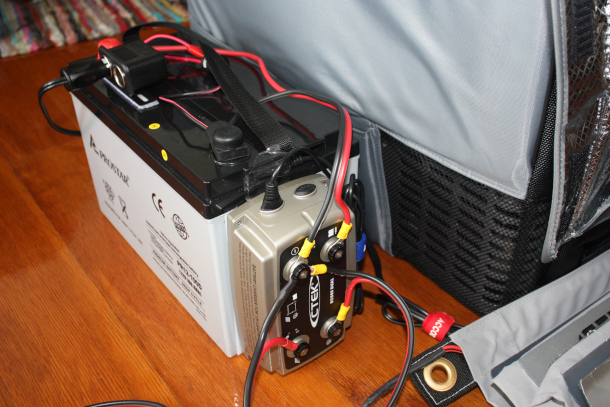Virtual Power Plants
Air Date: Week of November 3, 2023

VPPs are networks of small energy-producing and storage devices, such as solar panels and batteries, that are pooled together to serve the electricity grid. (Photo: Hiro Yamagata, Flickr, CC BY-SA 2.0)
The aging grid is struggling to accommodate the surge in renewables like wind and solar . And since they don’t produce electricity around the clock, there’s often a mismatch between when the power is being generated and when it’s being used. Ryan Hledik of the consulting firm The Brattle Group explains to Host Steve Curwood how “virtual power plants” can tap home and electric vehicle batteries and shift the timing of HVAC and appliance demand to help close this gap.
Transcript
CURWOOD: Electric vehicles aren’t just useful for getting you and me from Point A to Point B. With smart policies they could also help decarbonize the grid. That’s because renewables like wind and solar don’t produce electricity around the clock. So there’s often a mismatch between when the power is being generated and when it’s being used. And until it’s needed the big batteries in electric cars and trucks can help store some of that precious power. That’s part of the strategy called “virtual power plants.” A recent report by the consulting firm The Brattle Group estimates that virtual power plants could save utilities and their customers as much as $35 billion over the next decade. Ryan Hledik is a Principal at The Brattle Group and joins us now. Welcome to Living on Earth, Ryan!
HLEDIK: Thanks for having me.
CURWOOD: So what exactly is a virtual power plant? Please explain how they would operate.
HLEDIK: So a virtual power plant is basically a collection of customers, it could be residential households, it could be commercial buildings who have been recruited into a program and are participating in that program and being provided incentives to participate in order to provide some of these services to the grid. It's basically this idea where customers have a lot of flexibility in their demand for electricity. Customers who are buying electric vehicles have the ability to change when they're charging that car to a degree, customers with smart thermostats can manage the thermostat in a way that changes when they're cooling their home. So one example of this could be if you're a customer who had made an investment in a battery at your home, because you wanted to use that battery as a form of backup power during an outage, you could be paid by your local utility or another company to actually allow them to control that battery on a limited number of days per year, limited number of hours per day, to provide services to the grid from the battery. By doing this, the really interesting opportunity that we're seeing here is, first of all, it's a way to directly pay customers to participate in the decarbonisation transition. And then in addition to that, instead of going out and building a gas peaker plant that might only be used 100 hours per year, we're able to tap into an investment that's already been made for other reasons that customers battery, and get more use out of that to provide more of a benefit to the power grid and to society more broadly.

Graph from Brattle Group pointing to costs and savings from virtual power plants. (Photo: Courtesy of The Brattle Group)
CURWOOD: What role do electric cars play in the world of virtual power plants? They have pretty sizable batteries in them.
HLEDIK: Electric cars have sizable batteries, and they're a pretty large discretionary source of flexible electricity demand. So there's a lot of excitement about the potential for electric vehicles to participate in virtual power plant programs, projections that I've seen forecasted that, based on what we're likely to see in terms of electric vehicle adoption, over the course of the next decade, we could have dramatically more energy storage connected to the power grid in the form of electric vehicles and batteries on wheels, then we will see in terms of large utility scale batteries being deployed onto the power grid. So the idea with incorporating electric vehicles into a virtual power plant is that by encouraging customers to shift their charging to those off-peak hours in the middle of the night, when demand is low, or even in the middle of the day, when maybe there's solar power that's being curtailed, because you have more than you need, you can shift the charging load of the EVS into those hours to provide benefits that you otherwise wouldn't have if the customers were to just simply drive home from work and plug their electric vehicle into the wall when they got home.
CURWOOD: But what if somebody wants to get in that car right now and then wants to drive the 200 miles to Aunt Thelmas because she called saying she has an issue?

Graph from the Brattle Group explaining the virtual power plants. (Photo: Courtesy of The Brattle Group)
HLEDIK: That's right and one of the important characteristics of virtual power plant programs is they are designed with constraints on how they'll be used to make sure that customer comfort and convenience is maintained. So in the case of an electric vehicle, virtual power plant, you could have a program designed such that customers are always ensured that even if their utility is going to manage how that vehicle is charging overnight, that they will be starting the next day at 6am with a full state of charge in their EV. So those parameters, those rules are built into the program to make sure that they align with customer needs and customer convenience.
CURWOOD: What kind of money could we save in this country if we use virtual power plants rather than trying to just expand the traditional grid infrastructure?
HLEDIK: We looked into the answer to that question in our study and what we found was if we reached a pretty significant but achievable level of virtual power plant deployment by 2030, we could save 15 to $35 billion over the ensuing decade, relative to if we were to make investments and those more conventional gas peakers and utility scale batteries.
CURWOOD: So right now, the burning of fossil fuels in this country is linked to some 300,000 excess deaths a year. What are some of the co-benefits of dealing with the greenhouse gas problem using virtual power plants?

A virtual battery is like a piggy bank that allows you to store the surplus from your solar panels and convert it into a financial discount on your electricity bills. (Photo: Stephan Ridgway, Flickr, CC BY 2.0)
HLEDIK: In our study, we did look at the societal benefits associated with reduced greenhouse gas emissions that would come from the virtual power plant that we modeled. And we estimated that over that same 10 year period, at the level of deployment that I described, there can be an additional $20 billion of benefits associated with improved health and avoiding other detrimental effects that are associated with carbon emissions.
CURWOOD: Let's go back to electric cars for a moment. One of the strange things about electricity is that when you make it, it vanishes unless you figure out some way to store it. But the big old base power plants like nuclear plants, which is I think it's what 20% of the electricity in this country right now or the coal fired power plants, the middle of the night, they're cranking out electricity that's not being used that's just going away, just being wasted. It just disappears, it dissipates unless it's stored somehow. How can the virtual power plant notion take advantage of that? If this could be used to soak up some of that energy that otherwise would go to waste? I mean, charging cars, the middle the night is an obvious one but what are some of the other ways that we could take advantage of that baseload that right now goes to waste?
HLEDIK: It's interesting, and California has, and parts of the Southwest have seen this issue pretty acutely. And those are areas of the US where there's been a lot of solar generation that has been built over the course of the last several years. And so on a mild day, when there's not a lot of demand for electricity in the middle of the day, what we're seeing is there can be times when the sun is shining, when there's a lot of generation, actually, you have baseload generation, and then you have a lot of generation coming from the solar panels that can't be consumed for the reasons that you just described, supply exceeds demand. So providing customers with an incentive to shift their electric vehicle charging load into those hours is one opportunity. But another example would be if customers were to pre cool their homes during that midday period, so that they didn't need to run their air conditioners as much during the evening period. That's one way to shift some of their electricity consumption to the middle of the day. Another option that we've seen, that has been very effective, has been for customers with electric water heaters to use the electric water heater, essentially as a thermal battery, and to use the storage tank of that water heater to heat the water when it makes sense when the sun is shining, when there's more electricity than you need on the system. And then as long as the tank has hot water in it when the customer needs to take their shower, then the customer can take their shower without even noticing any difference in this service that they've received what are called smart water heaters or grid-interactive electric water heaters are a really useful resource for tapping into that type of potential.

Ryan Hledik is a Principal of the Brattle Group. Mr. Hledik specializes in regulatory and planning matters related to the emergence of distributed energy technologies. (Photo: Courtesy of Ryan Hledik)
CURWOOD: You know, it's interesting, this notion of say pre-cooling a home, it goes against conventional wisdom, people would think well, I don't want to leave the air conditioning on all day when I'm not there. When I come home is when I want to be cool. But virtual power plant thinking inverts that, huh?
HLEDIK: It inverts that and again provides customers with the financial incentive to do something that's good for the power grid and ultimately helps us achieve our decarbonisation goals. One state that you might not immediately think of that has a really interesting program is Vermont and the utility Green Mountain Power in Vermont, where the utility is providing customers with subsidized batteries that the customers get to install in their homes, the customers benefit from having that battery available as a form of backup power. But in return for receiving that heavily discounted battery from the utility, the utility gets to manage that battery during certain days of the year to provide benefits to the power grid. And it's a really interesting kind of win, win situation because the customer gets that resilience benefit, the utility is able to reduce costs on the power grid and keep the power grid reliable. And then on top of that Green Mountain Power is focusing on deploying these batteries in locations of their grid that have lower than average reliability, and where there are customers with lower than average incomes. So it's a great way to provide a lot of benefits in a lot of different ways through a single virtual power plant program.
CURWOOD: All right, well, let's cut to the chase here. This seems like a almost a no brainer idea to move into the area of virtual power plants. What's standing in the way? What are some of the barriers we're seeing when it comes to expanding virtual power plants?
HLEDIK: Well, right now, utilities don't have a strong incentive to adopt virtual power plants. The way utilities make money is by earning a return on capital investment in conventional power grid infrastructure. Poles and wires and power plants. Utilities don't have that same profit opportunity if instead they're using that money to pay customers to reduce their electricity demand. So where I'm hoping we're going to see innovation is around changing the utility regulatory model in a way that provides utilities with an incentive financially to go out and pursue virtual power plants. The other thing that I think is interesting to note here is electrification of transportation and heating is a real opportunity for electric utilities. Not only to be part of the decarbonisation transition and a central player in that, but also it's an opportunity for them to go out and build out power systems and earn a return on those investments to make sure that electrification is happening. And so in that sense, virtual power plants are going to become an enabler for utilities to go out and deploy more capital because it will be part of the agreement with the regulators to do that.
CURWOOD: Ryan Hledik is a Principal at the Brattle Group. Thanks so much for taking the time with us today.
HLEDIK: Thanks for having me on. I really appreciate it.
Links
Learn more about the Brattle Group study on virtual power plants.
Living on Earth wants to hear from you!
Living on Earth
62 Calef Highway, Suite 212
Lee, NH 03861
Telephone: 617-287-4121
E-mail: comments@loe.org
Newsletter [Click here]
Donate to Living on Earth!
Living on Earth is an independent media program and relies entirely on contributions from listeners and institutions supporting public service. Please donate now to preserve an independent environmental voice.
NewsletterLiving on Earth offers a weekly delivery of the show's rundown to your mailbox. Sign up for our newsletter today!
 Sailors For The Sea: Be the change you want to sea.
Sailors For The Sea: Be the change you want to sea.
 The Grantham Foundation for the Protection of the Environment: Committed to protecting and improving the health of the global environment.
The Grantham Foundation for the Protection of the Environment: Committed to protecting and improving the health of the global environment.
 Contribute to Living on Earth and receive, as our gift to you, an archival print of one of Mark Seth Lender's extraordinary wildlife photographs. Follow the link to see Mark's current collection of photographs.
Contribute to Living on Earth and receive, as our gift to you, an archival print of one of Mark Seth Lender's extraordinary wildlife photographs. Follow the link to see Mark's current collection of photographs.
 Buy a signed copy of Mark Seth Lender's book Smeagull the Seagull & support Living on Earth
Buy a signed copy of Mark Seth Lender's book Smeagull the Seagull & support Living on Earth

